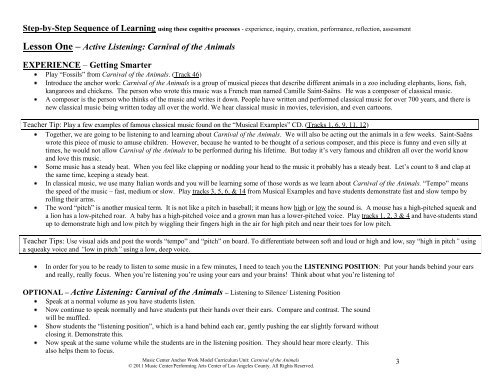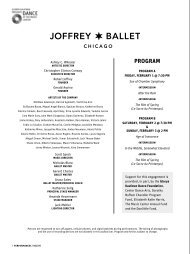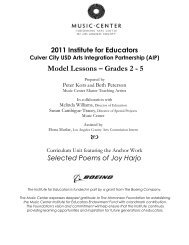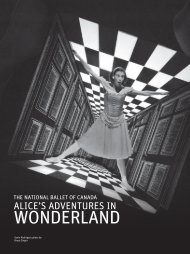Carnival of the Animals - Music Center
Carnival of the Animals - Music Center
Carnival of the Animals - Music Center
Create successful ePaper yourself
Turn your PDF publications into a flip-book with our unique Google optimized e-Paper software.
Step-by-Step Sequence <strong>of</strong> Learning using <strong>the</strong>se cognitive processes - experience, inquiry, creation, performance, reflection, assessment<br />
Lesson One – Active Listening: <strong>Carnival</strong> <strong>of</strong> <strong>the</strong> <strong>Animals</strong><br />
EXPERIENCE – Getting Smarter<br />
Play “Fossils” from <strong>Carnival</strong> <strong>of</strong> <strong>the</strong> <strong>Animals</strong>. (Track 46)<br />
Introduce <strong>the</strong> anchor work: <strong>Carnival</strong> <strong>of</strong> <strong>the</strong> <strong>Animals</strong> is a group <strong>of</strong> musical pieces that describe different animals in a zoo including elephants, lions, fish,<br />
kangaroos and chickens. The person who wrote this music was a French man named Camille Saint-Saëns. He was a composer <strong>of</strong> classical music.<br />
A composer is <strong>the</strong> person who thinks <strong>of</strong> <strong>the</strong> music and writes it down. People have written and performed classical music for over 700 years, and <strong>the</strong>re is<br />
new classical music being written today all over <strong>the</strong> world. We hear classical music in movies, television, and even cartoons.<br />
Teacher Tip: Play a few examples <strong>of</strong> famous classical music found on <strong>the</strong> “<strong>Music</strong>al Examples” CD. (Tracks 1, 6, 9, 11, 12)<br />
Toge<strong>the</strong>r, we are going to be listening to and learning about <strong>Carnival</strong> <strong>of</strong> <strong>the</strong> <strong>Animals</strong>. We will also be acting out <strong>the</strong> animals in a few weeks. Saint-Saëns<br />
wrote this piece <strong>of</strong> music to amuse children. However, because he wanted to be thought <strong>of</strong> a serious composer, and this piece is funny and even silly at<br />
times, he would not allow <strong>Carnival</strong> <strong>of</strong> <strong>the</strong> <strong>Animals</strong> to be performed during his lifetime. But today it‟s very famous and children all over <strong>the</strong> world know<br />
and love this music.<br />
Some music has a steady beat. When you feel like clapping or nodding your head to <strong>the</strong> music it probably has a steady beat. Let‟s count to 8 and clap at<br />
<strong>the</strong> same time, keeping a steady beat.<br />
In classical music, we use many Italian words and you will be learning some <strong>of</strong> those words as we learn about <strong>Carnival</strong> <strong>of</strong> <strong>the</strong> <strong>Animals</strong>. “Tempo” means<br />
<strong>the</strong> speed <strong>of</strong> <strong>the</strong> music – fast, medium or slow. Play tracks 3, 5, 6, & 14 from <strong>Music</strong>al Examples and have students demonstrate fast and slow tempo by<br />
rolling <strong>the</strong>ir arms.<br />
The word “pitch” is ano<strong>the</strong>r musical term. It is not like a pitch in baseball; it means how high or low <strong>the</strong> sound is. A mouse has a high-pitched squeak and<br />
a lion has a low-pitched roar. A baby has a high-pitched voice and a grown man has a lower-pitched voice. Play tracks 1, 2, 3 & 4 and have students stand<br />
up to demonstrate high and low pitch by wiggling <strong>the</strong>ir fingers high in <strong>the</strong> air for high pitch and near <strong>the</strong>ir toes for low pitch.<br />
Teacher Tips: Use visual aids and post <strong>the</strong> words “tempo” and “pitch” on board. To differentiate between s<strong>of</strong>t and loud or high and low, say “high in pitch” using<br />
a squeaky voice and “low in pitch” using a low, deep voice.<br />
In order for you to be ready to listen to some music in a few minutes, I need to teach you <strong>the</strong> LISTENING POSITION: Put your hands behind your ears<br />
and really, really focus. When you‟re listening you‟re using your ears and your brains! Think about what you‟re listening to!<br />
OPTIONAL – Active Listening: <strong>Carnival</strong> <strong>of</strong> <strong>the</strong> <strong>Animals</strong> – Listening to Silence/ Listening Position<br />
Speak at a normal volume as you have students listen.<br />
Now continue to speak normally and have students put <strong>the</strong>ir hands over <strong>the</strong>ir ears. Compare and contrast. The sound<br />
will be muffled.<br />
Show students <strong>the</strong> “listening position”, which is a hand behind each ear, gently pushing <strong>the</strong> ear slightly forward without<br />
closing it. Demonstrate this.<br />
Now speak at <strong>the</strong> same volume while <strong>the</strong> students are in <strong>the</strong> listening position. They should hear more clearly. This<br />
also helps <strong>the</strong>m to focus.<br />
<strong>Music</strong> <strong>Center</strong> Anchor Work Model Curriculum Unit: <strong>Carnival</strong> <strong>of</strong> <strong>the</strong> <strong>Animals</strong><br />
© 2011 <strong>Music</strong> <strong>Center</strong>/Performing Arts <strong>Center</strong> <strong>of</strong> Los Angeles County. All Rights Reserved.<br />
3






